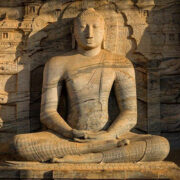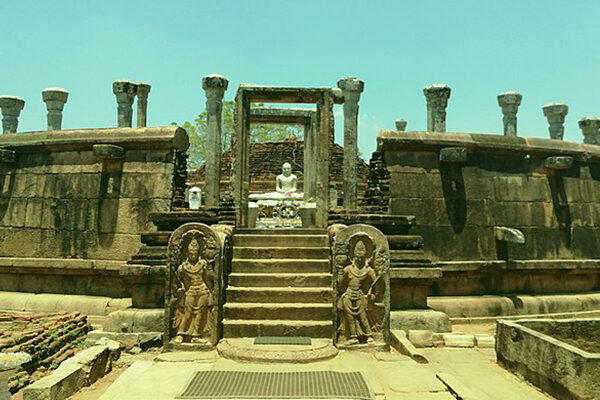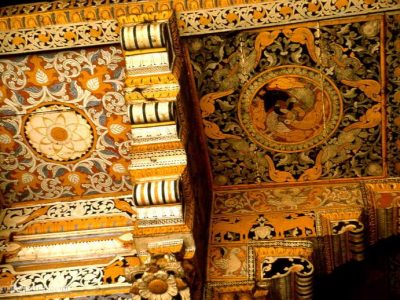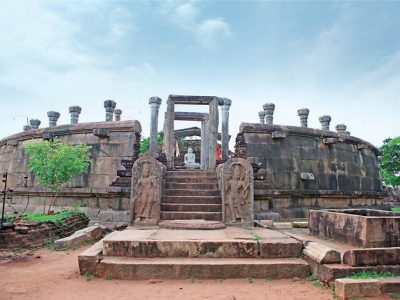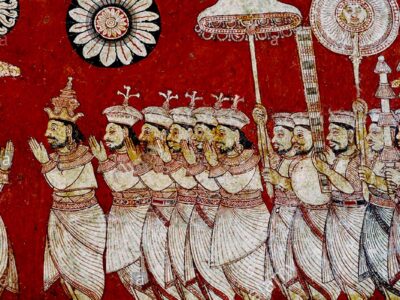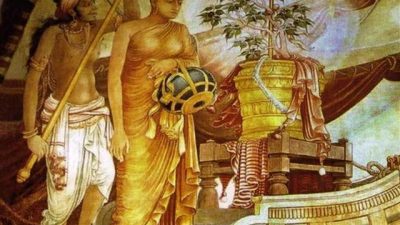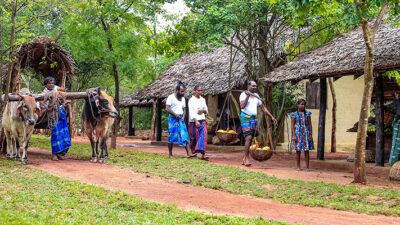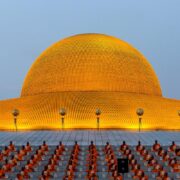The Venerable Pandit Dr. Medagama Vajiragnana, Viharadhipati of the London Buddhist Vihara and the Chief Sanghanayaka of Great Britain, was in Sri Lanka on a brief visit. Before his departure, he spoke to Nemsiri Mutukumara on the progress of Buddha Sasana in the West with special reference to England.
During the last 49 years, that is after 1954, Great Britain and the countries in the European continent have witnessed a remarkable growth in both quality and quantity turning a new leaf in their behavioural patterns in their way of living, says the Venerable Pandit Dr. Medagma Vajiragnana, Chief Sanghanayaka of Great Britain.
He is also the Viharadhipati of the Lodnon Buddhist Vihara founded and established by Sri Lanka’s Anagarika Dharmapala in 1926 at Gloucester Road, Regents Park in London.
Despite the Vihara being closed during the Second World War – 1939 to 1945 and the building acquired by the British Government and the return of the three resident Bhikkhus – the Ven. Dr. Paravahera Vajiragnana, Ven. Dehigaspe Pannasara and Hegoda Nandasara to Sri Lanka, the desire of the British who were yearning for a new way of life continued undiminished.
Fundamental message
The fundamental message of the Buddha “Shun evil and do good” and the Noble Eightfold Path with the layman’s code of ethics which is for all times and all climes etched in their minds indelibly making them comprehend the futility of bloodshed taking place in Europe and elsewhere during the second World War.
Ven. Vajiragnana recalled that despite the end of the war in 1945, the Mahabodhi Society could open the Vihara only in 1954. Immediately after the war many Sri Lankan business entrepreneurs went to London for business activities.
Sir Cyril de Zoysa, a successful entrepreneur, politician and Buddhist leader met several leading Buddhists who urged him to re-open the London Buddhist Vihara.
On his return Sir Cycil rallied round Hewavitarana and Amarasuriya families among other Buddhists and formed the London Buddhist Vihara Society in Sri Lanka to fund the re-establishment of the Buddhist Vihara.
First resident bhikkhu
A small building was rented out just behind the famous Harrods shop – a place visited by the British as well as foreign visitors. The location was 10, Ovington Gardens.
The Venerable Narada, quite popular for his Sermons as well as writings in both Sinhala and English became the first resident bhikkhu.
After a few months, the Ven. Mirisse Gunasiri succeeded him. He was followed by the Venerable Dr. Hammalawa Saddhathissa who came from India to head the London Buddhist Vihara.
For ten years, the Ovinton Gardens became a popular place for those seeking peace and contentment with renewed interest. The management committee was informed that the British Government has paid compensation for the takeover of the Buddhist Vihara building and the money can be utilized for a spacious place to accommodate the increasing number of seekers of the truth.
A two-storeyed building was purchased at No. 5, Heathfield Gardens. The Vihara was ceremonially opened by Dr. Gunapala Piyasena Malalasekera, Sri Lanka’s High Commissioner in England in 1964.
With every passing day, the British Buddhists as well as the cosmopolitan population in England as well as those visiting Europe were looking forward to a visit the Vihara.
By this time, the impact of the message was so popular; every university in Great Britain set up a seat, a department or a faculty for the Teaching of Buddhism.
Books on Buddha Dhamma began rolling out of many prestigious establishments both educational and commercial like the Cambridge and Oxford Universities, Keagan Paul and Company, Allan Unwin and Company and so on.
The London Pali Text Society (PTS) started by Dr. Rhys Davids printed and published Buddha Dhamma in English language and Pali texts in Romana Character.
In fact, the PTS prepared a new alphabet to write Pali and Sinhala words without giving those words an Anglican touch which today is accepted as standard throughout the world.
About fifteen years ago, there was a popular clamour that religious knowledge should be a compulsory subject in all government schools. Ven. Pandit Dr. Vajiragnana was entrusted to prepare the handbook for the teaching of Buddha Dhamma in government schools.
Over the last ten years, Great Britain has created history in making Buddhism, Christianity, Hinduism, Islam, Judaism and Sikkhism as compulsory subjects in British government schools.
Ven. Vajiragnana said the Britain has surpassed Sri Lanka in that respect.
The Nayaka thera said in some cases where teachers cannot be found to teach any particular religion, a Christian teacher fills the void and teaches the subject according to the prepared text book.
Ven. Vajiragnana stated a golden opportunity dawned for Sri Lankan Bhikkhu Sangha to teach Buddhism in British schools.
Those willing to take up the opportunity had to necessarily be proficient in English Language and thorough with the Buddha Dhamma, the spread of the Dhamma from the first year of Buddha’s dispensation which started with the dispatching of sixty Arahats in sixty different places in India and the sending of Dhamatutas by Emperor Asoka throughout the North-West India reading Greece and Egypt and in the North-Eastern regions to Korea and Japan.
Young minds
Additionally, every religious teacher should equip themselves with a sound basic knowledge and understanding of the other five religions in order to explain the subject to the young minds.
The Lancaster University, Vajiragnana Nayaka Thera explained is well-known as a promoter of Buddhist studies. A number of Bhikkhu Sangha have had their post graduate training at Lancaster and obtained post graduate doctorates as well. The teaching of Buddha Dhamma in schools and universities is not a mere academic exercise, he said.
Particularly, the teaching of Buddha is borne out of a dire need felt by the British and those in the Western world. Almost all Western countries are highly economically developed. The Westerners have the most affluent societies. They do not know what to do with their monetary and material resources they have acquired.
Sadly, they have everything at the pressing of a button or a click of a switch. Regrettably, their traditional way of life has failed miserably to provide some food for the cultivation of the mind. Mind culture is conspicuous with its absence. Meditation is a new term for them. Meditation draws them like a tortoise to a pond.
Bhavana sessions
Westerner’s deep and abiding interest in Buddhist mediation has witnessed Bhavana centres coming up everywhere. In places where a Buddhist Vihara or a Buddhist centre is not found, people hire public halls for Bhavana sessions – paying quite handsomely for the half-day session on mind control exercises given by the Bhikkhus.
After London Buddhist Vihara, many other Asian communities have opened Viharas in the outskirts of London. Viharas built by Governments of Myanmar, Thailand, Laos, Cambodia and China are patronized by and large by those respective nationals.
Buddhist communities in Korea, Japan, Taiwan, Nepal, India and Bangladesh have their own Viharas supported heavily by the Buddhists back home.
Several Lamaseries with big Lama Communities – disciples of His Holiness the Dalai Lama are supported by the Dalai Lama’s government in exile and large, following His Holiness in the Western world.
Maha Bodhi Society
The biggest achievement of the Anagarika Dharmapala’s pioneering Dhammaduta work through their Maha Bodhi Society is the coming up of the Amaravati Vihar at Hertfordshire. Men and women from fourteen countries in Europe reside in Amaravati as Samaneras, full-fledged Bhikkhus and Ten Preceptor Buddhist Nuns. Nuns provide a supplementary and complimentary role at Amaravati. Amaravati has opened a branch at Chithurst too.
The Head of Amaravati is a former British solider at the Vietnam War. He on retirement, renounced the lay life and entered the order of the Bhikkhu Sangha as a pupil of Ajahn Chah one of the foremost meditation masters in the world living in Thailand.
The new Bhikkhu was named Ajahn Sumedho. Ven. Sumedho is no foreigner to Sri Lanka. He has visited Sri Lanka many times and conducted Bhavana and delivered Dhammadesana too.
With the London Buddhist Vihara as the nucleus, Ven. Vajiragnana described the role the Vihara has played in the dissemination of Dhamma in France, Germany, Netherlands, Switzerland, Norway, Sweden, Italy as well one would be surprised to know that Buddhist Vihara is found close to the Vatican too.
With the disintegration of the Soviet system, many East European countries have gone back to the glorious days of Buddhism.
Already Kalmyk Republic, where the preponderant majority is Buddhists has elected a young Buddhist leader in his late thirties as the New President of Kalmykia.
His first task had been to proclaim Buddhist as the state religion and the re- opening of all Viharas which had been closed during the dictatorial communist regime of the Soviet Union.
Buddha Sasana
All the Bhikkhus who had left Kalmykia are returning to their old viharas and vigorously working for the development of Buddha Sasana. Quite often, the Bhikkhus in London Vihara are united to conduct Sarvaratrika Dharmadesana and ordination of youth and Samaneras in the continental countries.
Sri Lankan Bhikkhu Sangha in those countries too as in London and elsewhere support the Sri Lanka Viharas.
They of course are keen to observe and practice puja. In their time table, priority is given to rituals. Bhavana still seems to enjoy a second class berth.
The Sri Lankan Bhikkhu Sangha provides their best to cater to the Bhavana conscious Westerners to fulfill their need as well as practice the puja for ritual conscious people as they require. Eventually both groups will achieve mental satisfaction of accomplishing their target which is the most important aspect of the matter.
By Venerable Pandit Dr. Medagama Vajiragnana Thera.
Former Chief Sangha Nayaka Great Britain.


